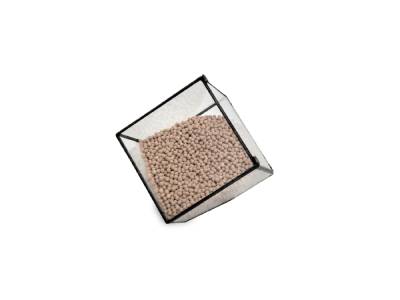A Molecular Sieve is a porous material with very small, uniformly sized pores. It works similarly to a kitchen sieve, except that it separates a gas mixture containing multi-sized molecules on a molecular scale. Only molecules smaller than the pores can pass through; while larger molecules are blocked. Molecular sieves can also be separated by polarity if the molecules you want to separate are of the same size. Sieves are widely used as dehumidifying and drying agents and help prevent degradation of products.
There are different types of molecular sieves, such as 3A, 4A, 5A and 13X. The numerical values define the size of the pores and the chemical composition of the sieve. The ions of potassium, sodium and calcium are altered in the composition to control the pore size. Different sieves have different numbers of meshes. Molecular sieves with a smaller number of meshes are used to separate gases, while those with a larger number of meshes are used to separate liquids. Other important parameters of molecular sieves include form, bulk density, regeneration temperature, moisture, etc.

Molecular Sieve
Silica gel can also be used as a dehumidifier and desiccant, but is very different from molecular sieves. Different factors that can be considered when choosing between the two are assembly options, pressure variations, humidity, mechanical forces, temperature range, etc. The main difference between molecular sieves and silica gel is.
The adsorption rate of molecular sieves is greater than that of silica gel. This is because molecular sieve is a fast drying agent. At high temperatures, molecular sieve functions better than silica gel because it has a more uniform structure and binds water firmly. At low relative humidity, molecular sieves are far more capable than silica gel. Molecular sieves have a defined structure with uniform pores, while silica gel has an amorphous structure with multiple irregular pores.
Molecular Sieve Suppliers tell us that to activate a molecular sieve, the basic requirement is to be exposed to ultra-high temperatures, with heat high enough to vaporize the adsorbate. The temperature will vary with the material being adsorbed and the type of adsorbent. For the sieve types discussed earlier, a constant temperature range of 170-315oC is required. Both the material being adsorbed and the adsorbent are heated at this temperature. Vacuum drying is a faster method and requires a relatively low temperature compared to flame drying.
Once activated, the sieves can be stored in a glass container, wrapped in a double layer of film. This will allow them to remain active for up to six months. To check if the sieves are active, you can hold them in your hands with gloves on and add water to them. If they are fully active, then the temperature will rise significantly and you will not be able to hold them even with gloves on. The use of safety equipment such as PPE kits, gloves and safety glasses is recommended because the activation process of molecular sieves involves handling high temperatures and chemicals and the associated risks.
The company also offers Attapulgite Clay, contact us today for more information.
NEWSLETTER SIGNUP
By subscribing to our mailing list you will always be update with the latest news from us.
We never spam!
Copyright © Mingguang Feizhou new materials Co., Ltd. All Rights Reserved. | Sitemap | Technical Support: 